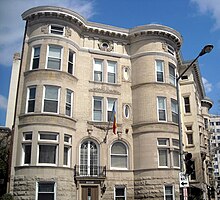

| Company type |
|
|---|---|
| Industry | Software, services, applications |
| Founded | 1969; 55 years ago (1969)inBethesda, Maryland, United States (as STSC)[1] |
| Founders |
|
| Fate | Acquired by JDA Software Group, July 2006 |
| Successor |
|
| Headquarters | , |
Number of locations | 30 offices |
Area served |
|
| Products | Prepackaged software[2] |
| Brands | APL*Plus |
| Owner | Continental Telecom, Inc. |
| Parent | Continental Telecom, Inc. |
| Website | jda |
Scientific Time Sharing Corporation (STSC) was a pioneering timesharing and consulting service company which offered APL from its datacenter in Bethesda, MD to users in the United States and Europe.

Scientific Time Sharing Corporation (STSC) was formed in 1969 in Bethesda, Maryland by Dan Dyer, Burton C. Gray, and some of the people who originally implemented the programming language APL, notably Philip S. Abrams, Lawrence M. Breed, and Allen Rose.[3] In 1970, STSC released APL*Plus, a version of the APL\360 language with many practical extensions oriented toward fostering business use of APL. Together with I. P. Sharp Associates, STSC made many enhancements to the APL language, including:
STSC continued to make enhancements to the interpreter, notably improving the performance of many of the primitive functions.
In 1985, Dan Dyer of STSC and Ian Sharp of I. P. Sharp Associates jointly received the Kenneth E. Iverson Award for Outstanding Contribution to APL.
In the early 1980s, the timesharing market began collapsing, mostly due to the appearance in the marketplace of relatively lower cost IBM mainframe computers, such as the IBM 4300. STSC quickly changed its focus to supply APL services for in-house and the rapidly developing personal computer (PC) market.
In 1982, STSC released APL*Plus/PC, which was a very successful APL interpreter for the IBM personal computer. In the mid 1980s, STSC developed the APL*Plus/Unix interpreter, a full 32-bit interpreter which was the basis of further APL development, notably APL*Plus/386, which was later available for Intel 386 class machines and higher. Arguably, the APL*Plus/386 interpreter fostered the exodus of APL applications from mainframe to PC environments, as the hardware and software were finally correctly matched to facilitate a straightforward migration of medium- to large-sized applications away from mainframes.
In the mid 1980s, STSC released an APL compiler for its APL*Plus add-on for the IBM VSAPL program product. Along with language features designed to profile code execution, this compiler implementation was oriented toward replacing resource-consuming functions in place with compiled ones, leading to overall performance improvements.
By the mid 1990s, the APL*Plus/386 system had become one of the leading APL interpreters in the market, however it did not run under the then-new Microsoft Windows 3.1. Although there were some attempts at Windows interoperability, development on the APL*Plus/Win product began shortly before the APL products were sold to LEX2000. This latest Windows product is the basis for the current APLNow (formerly APL2000) interpreter product line.
Manugistics continued to own all supply chain software.
The Jimmy Carter and Walter Mondale presidential campaign used the commercial STSC MAILBOX service to coordinate their campaign schedules. MAILBOX ran on a single Amdahl 470 system with dial-up and/or hardwired access intended for within-company access.
Powered by a big Amdahl 470 computer at STSC's Bethesda headquarters, it comprised a series of mailboxes assigned to Carter, Mondale and various other individuals and groups within the campaign staff. Toting portable terminals, Carter and Mondale were able to keep track of each other's frenetic schedules. Moreover, each was able to keep tabs on the other's public statements and positions to avoid catastrophic contradictions. Mailbox soon became the tie to bind the other computer applications that were already humming away in the political machine. If Mondale had an idea on tax reform, for instance, he would transmit it through Mailbox to Stuart Eisenstat in the issues room. Eisenstat would take a look at it, see if additional data was needed from the New York Times data bank, and then send the combination package to Carter. Even while airborne, Carter was constantly feeding messages to his mailbox. The jet wasn't connected to the system by radio hook-up, but magnetic tape devices were on board so typists could continue to capture data. Once Peanut One touched down, the telephone company would rush in with five pairs of communications lines, and the system would again start purring.
{{cite web}}: External link in |editor=|
| |||||||||||||
|---|---|---|---|---|---|---|---|---|---|---|---|---|---|
| Features |
| ||||||||||||
| Implementations |
| ||||||||||||
| Community |
| ||||||||||||
| |||||||||||||
| International |
|
|---|---|
| National |
|
| Other |
|